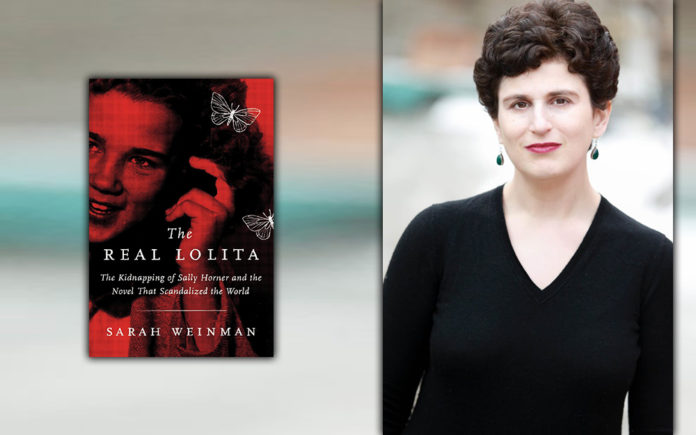
By Heidi Simmons
—–
The Real Lolita
by Sarah Weinman – Nonfiction
—–
The “#MeToo” movement has revealed that a big percentage of women all over the globe have experienced some kind of sexual abuse and/or harassment in their lives. Since the beginning of time, females have been at a disadvantage and susceptible to male deviant behavior. In Sara Weinman’s The Real Lolita: The Kidnapping of Sally Horner and the Novel That Scandalized the World (Ecco, 306 pages) a young girl is swept into a nightmare where not just one man took advantage of her, but maybe two.
Author Weinman is a crime writer and while seeking a mid-century story, came across an article about Sally Horner, an eleven-year-old girl, abducted by an opportunistic child molester and pedophile.
Sally Horner was born in 1937 and lived with her divorced mother in Camden, New Jersey. On a dare to fit in with the popular girls, Sally tried to steel a small notebook, but was “caught” by an older man, Frank LaSalle, who claimed he was an FBI agent. He promised he would not turn her in or tell her mother if Sally would go away with him.
La Salle was a in his fifties and a known child rapist who was out on parole. La Salle contacted Sally’s mother and asked her permission to take Sally away for a week at the beach telling her his own daughter and friends would also be along on the trip. Reluctantly, Mrs. Horner agreed, hoping to give Sally a much-needed break from their bleak lives.
But LaSalle did not take the child for a week with other girls, but took Sally alone for 21 months on a horrendous cross-country nightmare. He told those he came in contact with that Sally was his daughter. He regularly raped Sally and was constantly on the move to avoid law enforcement.
After Mrs. Horner reported the kidnapping of her daughter, it became a national news story. La Salle’s mug shot was hung in post offices across the nation. La Salle and Sally stayed in motels and campgrounds until a woman became suspicious and helped Sally call her family. With quick action, the police and local FBI rescued Sally and caught La Salle.
Weinman tells Sally’s story for two reasons: Sally’s story matters, and Sally’s abduction was likely the source material, “inspiration,” for Vladimir Nabokov’s Lolita.
Drawing on Sally’s story, Weinman makes connection to Nabokov’s seminal work. She points to passages, notes and interviews that suggest Nabokov did indeed glean material from news reports of Sally’s traumatic experience for his novel.
The Real Lolita is a fascinating and captivating survival tale of a young girl who got her life back but then died tragically just two years after her rescue.
Weinman is filled with righteous anger, not only for Sally, but other girls like Elizabeth Smart and Jaycee Dugard. Young girls abducted, raped and held as slaves are still in the news today. Weinman gives voice to the victims, acknowledges their personal resilience and their will to survive.
Finally, for Weinman, Sally was a real person, an innocent child, not a fictional teenage temptress in a popular novel. There is an outrage within her narrative that demonstrates the victim has been forgotten, while the novel’s pedophile protagonist continues to be popular in Nabokov’s celebrated work.
What makes this book incredibly readable are the connections Weinman makes to Nabokov, poet, butterfly collector and family man. Weinman claims that Nabokov was only able to complete his great work of fiction after hearing about Sally Horner’s abduction.
According to Weinman, Nabokov worked on a manuscript similar to Lolita for over twenty years using another title. Following Sally’s abduction, Nabokov took fives years to write Lolita. He tried to destroy his novel several times for reason unclear.
Nabokov wanted to use a pseudonym but had trouble finding a publisher because of the risqué and controversial subject matter. These details about Nabokov’s book Lolita coming to fruition are compelling and amazing.
I thoroughly enjoyed getting insight into Nabokov’s writing methodology and the struggles he had to get the book published – first in Europe and then in the US.
After reading The Real Lolita, I did not feel it made any difference to me whether Nabokov used or incorporated Sally’s experience in his work. I like Nabokov more now and appreciate how much time and effort went in to creating the difficult characters and the strange artistry of the bizarre and dangerous narrative.
It is the job of writers and artists to interpret our world, to glean from real life events so that we may better observe and understand what it means to be human –- even when we are twisted and sick.










































